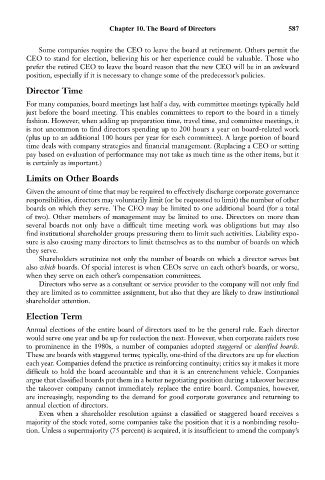Page 601 - Bruce Ellig - The Complete Guide to Executive Compensation (2007)
P. 601
Chapter 10. The Board of Directors 587
Some companies require the CEO to leave the board at retirement. Others permit the
CEO to stand for election, believing his or her experience could be valuable. Those who
prefer the retired CEO to leave the board reason that the new CEO will be in an awkward
position, especially if it is necessary to change some of the predecessor’s policies.
Director Time
For many companies, board meetings last half a day, with committee meetings typically held
just before the board meeting. This enables committees to report to the board in a timely
fashion. However, when adding up preparation time, travel time, and committee meetings, it
is not uncommon to find directors spending up to 200 hours a year on board-related work
(plus up to an additional 100 hours per year for each committee). A large portion of board
time deals with company strategies and financial management. (Replacing a CEO or setting
pay based on evaluation of performance may not take as much time as the other items, but it
is certainly as important.)
Limits on Other Boards
Given the amount of time that may be required to effectively discharge corporate governance
responsibilities, directors may voluntarily limit (or be requested to limit) the number of other
boards on which they serve. The CEO may be limited to one additional board (for a total
of two). Other members of management may be limited to one. Directors on more than
several boards not only have a difficult time meeting work was obligations but may also
find institutional shareholder groups pressuring them to limit such activities. Liability expo-
sure is also causing many directors to limit themselves as to the number of boards on which
they serve.
Shareholders scrutinize not only the number of boards on which a director serves but
also which boards. Of special interest is when CEOs serve on each other’s boards, or worse,
when they serve on each other’s compensation committees.
Directors who serve as a consultant or service provider to the company will not only find
they are limited as to committee assignment, but also that they are likely to draw institutional
shareholder attention.
Election Term
Annual elections of the entire board of directors used to be the general rule. Each director
would serve one year and be up for reelection the next. However, when corporate raiders rose
to prominence in the 1980s, a number of companies adopted staggered or classified boards.
These are boards with staggered terms; typically, one-third of the directors are up for election
each year. Companies defend the practice as reinforcing continuity; critics say it makes it more
difficult to hold the board accountable and that it is an entrenchment vehicle. Companies
argue that classified boards put them in a better negotiating position during a takeover because
the takeover company cannot immediately replace the entire board. Companies, however,
are increasingly, responding to the demand for good corporate goverance and returning to
annual election of directors.
Even when a shareholder resolution against a classified or staggered board receives a
majority of the stock voted, some companies take the position that it is a nonbinding resolu-
tion. Unless a supermajority (75 percent) is acquired, it is insufficient to amend the company’s

